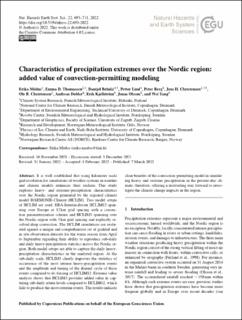| dc.contributor.author | Médus, Erika | |
| dc.contributor.author | Thomassen, Emma D. | |
| dc.contributor.author | Belušić, Danijel | |
| dc.contributor.author | Lind, Petter | |
| dc.contributor.author | Berg, Peter | |
| dc.contributor.author | Christensen, Jens Hesselbjerg | |
| dc.contributor.author | Christensen, Ole B. | |
| dc.contributor.author | Dobler, Andreas | |
| dc.contributor.author | Kjellström, Erik | |
| dc.contributor.author | Olsson, Jonas | |
| dc.contributor.author | Yang, Wei | |
| dc.date.accessioned | 2023-03-30T12:26:44Z | |
| dc.date.available | 2023-03-30T12:26:44Z | |
| dc.date.created | 2022-03-14T15:47:15Z | |
| dc.date.issued | 2022 | |
| dc.identifier.citation | Natural Hazards and Earth System Sciences. 2022, 22 (3), 693-711. | en_US |
| dc.identifier.issn | 1561-8633 | |
| dc.identifier.uri | https://hdl.handle.net/11250/3061186 | |
| dc.description.abstract | It is well established that using kilometer scale grid resolution for simulations of weather systems in weather and climate models enhances their realism. This study explores heavy- and extreme-precipitation characteristics over the Nordic region generated by the regional climate model HARMONIE-Climate (HCLIM). Two model setups of HCLIM are used: ERA-Interim-driven HCLIM12 spanning over Europe at 12 km grid spacing with a convection parameterization scheme and HCLIM3 spanning over the Nordic region with 3 km grid spacing and explicitly resolved deep convection. The HCLIM simulations are evaluated against a unique and comprehensive set of gridded and in situ observation datasets for the warm season from April to September regarding their ability to reproduce sub-daily and daily heavy-precipitation statistics across the Nordic region. Both model setups are able to capture the daily heavy-precipitation characteristics in the analyzed region. At the sub-daily scale, HCLIM3 clearly improves the statistics of occurrence of the most intense heavy-precipitation events and the amplitude and timing of the diurnal cycle of these events compared to its forcing of HCLIM12. Extreme value analysis shows that HCLIM3 provides added value in capturing sub-daily return levels compared to HCLIM12, which fails to produce the most extreme events. The results indicate clear benefits of the convection-permitting model in simulating heavy and extreme precipitation in the present-day climate, therefore, offering a motivating way forward to investigate the climate change impacts in the region. | en_US |
| dc.description.abstract | Characteristics of precipitation extremes over the Nordic region: added value of convection-permitting modeling | en_US |
| dc.language.iso | eng | en_US |
| dc.rights | Navngivelse 4.0 Internasjonal | * |
| dc.rights.uri | http://creativecommons.org/licenses/by/4.0/deed.no | * |
| dc.title | Characteristics of precipitation extremes over the Nordic region: added value of convection-permitting modeling | en_US |
| dc.title.alternative | Characteristics of precipitation extremes over the Nordic region: added value of convection-permitting modeling | en_US |
| dc.type | Peer reviewed | en_US |
| dc.type | Journal article | en_US |
| dc.rights.holder | © Author(s) 2022 | en_US |
| dc.description.version | publishedVersion | en_US |
| cristin.ispublished | true | |
| cristin.fulltext | original | |
| cristin.qualitycode | 1 | |
| dc.identifier.doi | 10.5194/nhess-22-693-2022 | |
| dc.identifier.cristin | 2009660 | |
| dc.source.journal | Natural Hazards and Earth System Sciences | en_US |
| dc.source.volume | 22 | en_US |
| dc.source.issue | 3 | en_US |
| dc.source.pagenumber | 693-711 | en_US |
| dc.relation.project | Meteorologisk institutt: 182010 | en_US |

